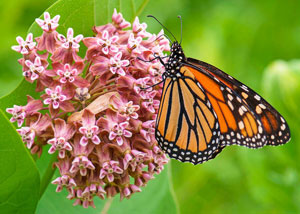
By Linda Wiggen Kraft,
Healthy Planet Green & Growing Editor
If bees, butterflies, birds, bats and other pollinators could put an advertisement out for the help they need, it would read: “help wanted– desperately needed pollinator gardeners”.Pollinators need us now more than ever to help them thrive and survive. In response to this need, groups of individuals and organizations dedicated to the environment have banded together to create the “Million Pollinator Garden Challenge”. The goal is to have individuals, communities, schools, cities, public parks, botanical gardens and garden places create and register over a million pollinator gardens throughout the United States in the next few years.
A pollinator garden is full of plants that offer pollen and food to the creatures who transfer pollen from one plant to another. This transfer of pollen allows plants to develop fruits, vegetables and create seeds.Without pollination this wouldn’t happen. One out of every three bites of food we take comes from a pollinated plant.
So what to plant? Native plants are the first choice. These plants and bees, insects, bat, birds and other pollinators have grown up together in the long time of evolution of an ecosystem.Their life cycles coincide with the blooming of certain plants and emergence of insects into their adult form. Insects with certain body parts that fit exactly into the shape of the blossom itself have evolved so plant and pollinator survive together. Many other beneficial relationships have evolved between native plants and native pollinators.
Pollinator gardens for the Pollinator Challenge can be small or large. They must contain plants that provide nectar and pollen with blooms from spring through fall, have a water source, be in sunny areas and at best use no pesticides.The Million Pollinator Garden Challenge website has many links to partners like the Xerxes Society and Monarch Watch that give tips on what to do to provide a habitat for monarchs and other pollinators.
The efforts of St. Louis City are recognized nationally as a place where monarch and pollinator gardens efforts are helping with the crisis of monarch butterflies needing milkweed (asclepias) plants to survive their migration to Mexico. The Milkweeds for Monarch program is extensive, and their website has tons of information about how to plan, plant and maintain a pollinator garden in our region.
Here are Milkweed for Monarchs criteria for a pollinator garden.
- Garden should contain 4 milkweed plants representing at least 2 different milkweed species (example: 2 Butterfly Weed plants and 2 Swamp Milkweed plants).
- Garden should contain 5 nectar plants representing at least 3 different species (example: 2 Purple Coneflower plants, 2 Goldenrod plants, and 1 Black-Eyed Susan plant).
- In total, garden should contain a minimum of 9 plants, covering at least one square meter (approximately 9 square feet).
There are many possibilities for creating a pollinator gardens. St. Louis City pollinator gardens can be registered on a map at their website. For those living inside and outside St. Louis City, pollinator gardens can be registered online at the Million Pollinator Garden Challenge.Wherever your garden is, let it be one of the million or more that is helping nurture and save our pollinators.
Linda Wiggen Kraft is a landscape designer who creates holistic and organic gardens. She is also a mandala artist and workshop leader. Visit her blog: CreativityForTheSoul.com/blog or website: CreativityForTheSoul.com.
Contact her at 314 -504-4266.


